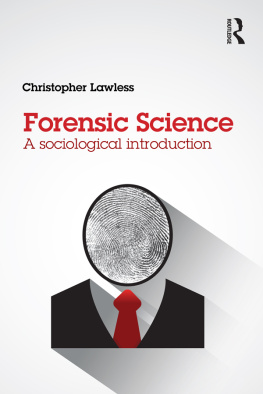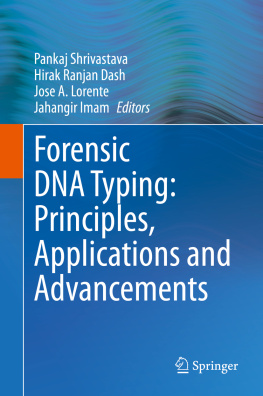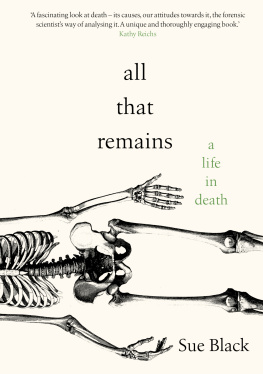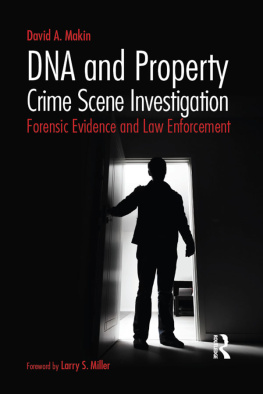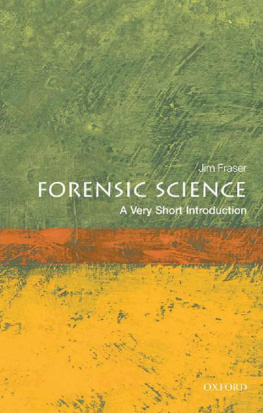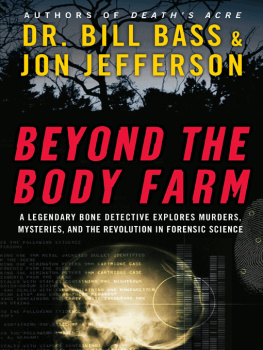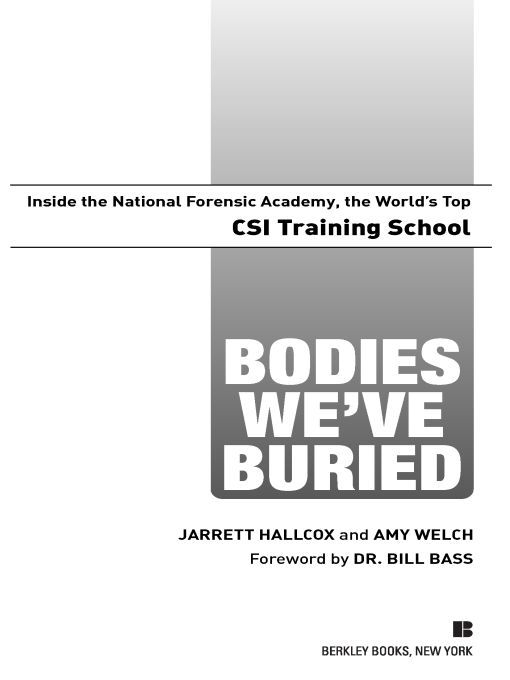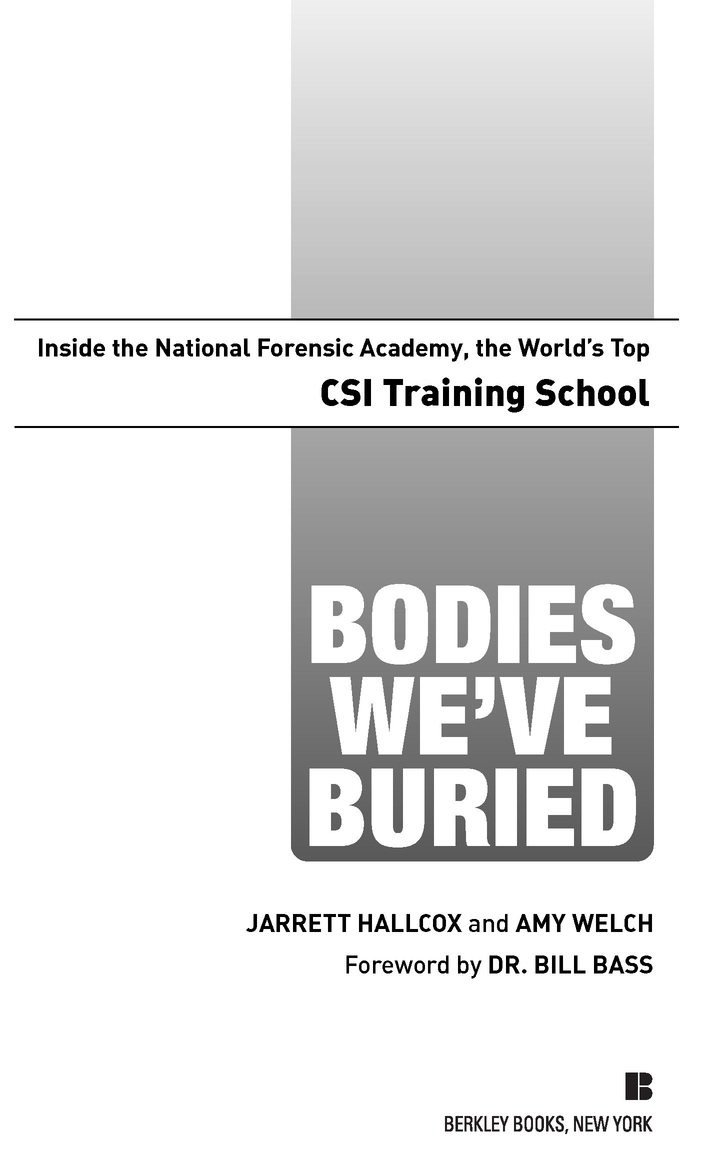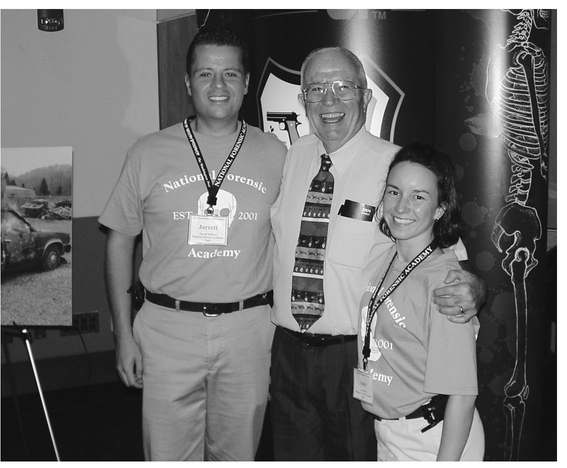Table of Contents
Praise for Bodies Weve Buried
The Academys rigorous, hands-on curriculum is not for the faint of heart or the queasy. The same could be said for the books vivid you-are-there descriptions that allow readers to feel every squish, smell every stench, see every spurt, gag at every swarm of maggots, cower at every potential bomb, share every arsonists awe and imagine every unimaginable depravity. People looking for an interesting read will enjoy sharing the challenges of the CSI training course and the behind-the-scenes stories that Hallcox and Welch recount. Their enthusiastic and comfortable style welcomes all readers, viewers and nonviewers of CSI alike, into their world.
Dr. Fred Bortz, Chicago Sun-Times
Hallcox and Welch take readers inside the worlds top CSI training school for a spooky, but fascinating, look at what they do and how they do it. The Knoxville News-Sentinel
When the National Forensic Academy opened its doors, administrators Hallcox and Welch were desperate for students; now they admit only police officers and have three-year-long waiting lists. Their book outlines the ten-week program and shares with readers the gritty reality of forensic work. The authors caution that the actual work is a lot less glamorous than it looks on TV and often involves crawling through the mud or examining putrid corpses. And nothing is as simple as it seems, from photographing crime sceneswhere the details, from film speed to lighting, are crucialto processing evidence, which is selectively sent off to a state lab to be dealt with. Students in the course also pay a visit to the infamous Body Farm, where they examine and analyze decomposing corpses. Given the popularity of CSI and its many imitators, many will find reading about the real science enlightening and engrossing.
Booklist
Most Berkley Books are available at special quantity discounts for bulk purchases for sales promotions, premiums, fund-raising, or educational use. Special books, or book excerpts, can also be created to fit specific needs.
For details, write: Special Markets, The Berkley Publishing Group, 375 Hudson Street, New York, New York 10014.
This book is dedicated to all of the graduates and instructors of the National Forensic Academy. Let the evidence always be your guide.
Life is far too important a thing ever to talk seriously about.
Oscar Wilde
FOREWORD
Dr. Bill Bass
I know of only two areas of science in which you must destroy in order to find out what is there. The first of these is an archaeological excavation, where you must dig up the site, interpret the stratigraphy, check for intrusions, and analyze the artifacts. The second of these is a crime scene search, about which this book is a guide of what to do, and even better, what not to do. In both cases you have only one chance to do your investigation, and if it is not done correctly the first time you never have a second opportunity, because you have destroyed what you were trying to solve.
The first step in both of the above situations is photography. You must have records of what the scene looks like before it is ever touched, and you must photograph every change that you make in the investigation.
I was fortunate that early in my career as a forensic anthropologist, a Kansas Bureau of Investigation (KBI) agent, Harold Nye, gave me the best information on photography that I have ever received. Harold told me that when you arrive at a crime scene, You shoot your way in and you shoot your way out. What Harold was saying is that for those of us who investigate crime scenes, when you arrive at the scene and get out of your car, take a picture before ever stepping into or on the scene. For example, lets take a house: When you get to the scene, take a picture of the house. Walk up to the front porch and take a picture. Open the door, and before stepping inside, take a picture of the hall or room. Never go into a room before you have taken a picture. As you leave the scene, repeat the picture-taking in reverse order.
A whole generation of investigators has worked on crime scenes since the 1959 murders of the Clutter family in western Kansas. Harold Nye was the lead KBI investigator in the Clutter murders, which led to a book about the case by Truman Capote entitled In Cold Blood. Harolds picture-taking led to one of the major breaks in that case. When Harold went down into the basement, he took a picture of the basement floor before ever stepping on it. After the initial crime scene investigation was over and the pictures had been developed (this was before digital cameras), Harold, while carefully inspecting the photograph, noted a shoe print that did not match any of the crime scene investigators shoes. This became a key piece of evidence in solving the crime.
It has been a longtime hope of mine that we could put together an in-depth course that would allow hands-on experiences for police officers involved in crime scene searches. This course is the fulfillment of that dream. You will find in the pages of this book how the crime scene investigator (CSI) gains actual experience in recovering evidence and interpreting that evidence after blowing up cars and setting cars on fire. Fire scenes in houses are reproduced, with all of the students gaining valuable experiences from investigating fire scenes after watching a room or building
The authors, Jarrett Hallcox and Amy Welch, with Dr. Bill Bass.(Copyright John Williams, collection of the National Forensic Academy)
burn. Few people, whether CSIs or not, have ever located and recovered a buried body or one scattered by animals. When a body decays on the ground, students are taught how to determine where the body first lay (where the hair mat has come off and the decay stain caused by the bodily fluids that leach out of the body during decomposition, also known as Volatile Fatty Acids).
The students in the National Forensic Academy (NFA) are taught how to locate a buried body, the proper excavation techniques, and how to recover the skeleton and artifacts left at the death scene. Prosthetic devices, such as hip and knee replacements, are handled by the students; when found in fire scenes they can help identify the deceased. This book sheds light on what a well-trained CSI looks for.
Bodies Weve Buried is a documentation of the training that goes into the education of a CSI. Most of you will be surprised and fascinated by what goes into the training of a good CSI. The authors, Jarrett and Amy, are not law enforcement officers, but are the staff members who put together the training that you will read about in the book. They have been surprised, as you will be, and have recorded their excitement for all of us to read.
For a number of years many of us in the forensic sciences and law enforcement have been concerned about the quality of training received by law enforcement officers and especially crime scene investigators. A few years ago the now-retired police chief of Knoxville, Phil Keith, and a number of us in the forensic area discussed the possibility of establishing an in-depth training program to bring the training of crime scene investigators up to the modern level of knowledge in the forensic sciences. Out of these discussions, and funded by federal grants, the NFA was born. Prior to the courses offered here, most training for CSIs was a lecture-type, one-to-five-day program, with little if any hands-on experience. This book, written by the two people who are in charge of the training of the crime scene investigators from all over the world, who are accepted into the NFAs ten-week course, will give you a day-by-day account of the trials and tribulations of finding material for the training sessions, of the humorous things in class, and of the establishment of lifelong friendships of the students and staff.



